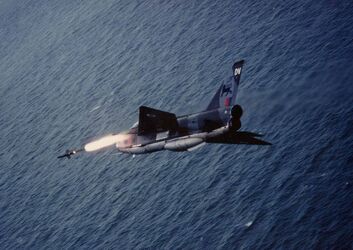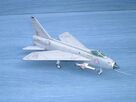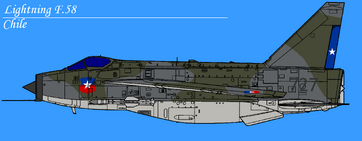The English Electric Lightning is a supersonic jet fighter aircraft of the Cold War era, which was famous for it's stupendous performance, easily sprinting to mach 2, and attaining a rate of climb of 20,000ft per minute.

Lightning firing a Blue Vesta AAM
RAF Variants[]
Lightning F.1/1A[]
Development batch aircraft, single-seat fighters delivered from 1959, a total of 19 built (and one static test airframe). Nose-mounted twin 30 mm ADEN cannon, two Firestreak missiles, VHF Radio and Ferranti AI-23 "AIRPASS" radar. The F.1A was a single-seat fighter, delivered in 1961. Featured Avon 210R engines, an in-flight refuelling probe and UHF Radio; a total of 28 built.
Lightning F.2/2A[]
An improved variant of the F.1A, delivered in 1962. A total of 44 were built with 31 older variants being later refitted to F.2A standard, five later modified to F.52 for export to Saudi Arabia. The F.2A was an F.2 upgraded to near F.6 standard featuring Avon 211R engines, retained ADEN cannon and Firestreak (replaceable Firestreak pack swappable with ADEN Cannon Pack for a total of four ADEN Cannons), arrester hook and enlarged Ventral Tank for two hours flight endurance. A total of 31 converted from F.2.
Lightning F.3/3A[]
Single-seat fighter with upgraded AI-23B radar, Avon 301R engines, new Red Top missiles, enlarged and clipped tailfin due to aerodynamics of carriage of Red Top, and deletion of ADEN cannon. A total of 70 built (at least nine were converted to F.6 standard). The F3A had extended range of 800 miles due to large ventral

RAF F6 version of the Far Eastern Air Force, 1970s
tank and new cambered wings. A total of 16 built at the end of F.3 production, known also as an F.3 Interim version or F.6 Interim version, 15 later modified to full F.6 standard.
Lightning T.4/T5[]
Two-seat side-by-side training version, based on the F.1A; two prototypes and 20 production built, two aircraft later converted to T.5 prototypes, two aircraft later converted to T.54. The T.5 trainer version was based on the F.3 airframe; 22 production aircraft built.
Lightning F.6[]
Single-seat fighter (an improved longer-range variant of the F.3). Featured new wings with better efficiency and subsonic performance, overwing fuel tanks and larger ventral fuel tank, reintroduction of 30 mm cannons (initially no cannons were fitted, but later were refitted in the forward part of ventral pack rather than in the nose), use of Red Top missile. Total of 39 built (also nine converted from F.3 and 15 from F.3A).
Lightning F.7[]

RAF Lightning F.7 armed with Blue Vesta
The F.7 was the last front line version and served almost exclusively in the RAuxAF. Based on the F.6, the aircraft was upgraded with Blue Fox radar and wired to fire the Radar Red Top AAM up to four of which could be carried thanks to the fitting of underwing pylons developed for the export version. The typical loadout was two Radar Red Top AAM and two Blue Vesta AAMs. A handful survived long enough to serve in the defence of RAF airfields during The '91 Disaster.
Export Variants[]
Lightningspark EF.59[]
During the 1980s, the Bush War in Angola was waged between the Commonwealth-supported South African forces and pro-Communist Cuban-supported forces. The Cubans brought with them advanced Soviet SAM support which began to take a high toll on Royal South African Air Force and Navy strike aircraft. The South Africans responded

South African Lightnings briefly served in the defence suppression role.
by developing a dedicated defence suppression version of the Lightning. The Lightnings were fitted with advanced radar warning receivers, and the cannons in the belly tank were removed to accommodate additional ECM equipment.
The main weapon the so-called Lightningspark was slated to use was the Red Heat ARM. This was a rebuilt Firestreak AAM with a radar wave directional finder within the nose in place of the infra-red scanner of the FIrestreak. When carried by the launch aircraft it could receive directional data from the aircraft's own radar warning receiver to assist with targeting before firing. The high speed and rapid climb-rate that the aircraft possessed meant that it could dive into a SAM’s radar coverage, fire it's Red Heat missiles and escape out of range quickly before the enemy could retaliate.
Commonwealth Operators[]
South Africa[]
South Africa ordered 35 F.56s in 1965 with training being undertaken in the UK on the RAF's two seat trainers. Royal South African Air Force Lightnings were always employed in a secondary light attack role with rockets and light bombs. Consequently, as SAMs became more prolific in Africa during the late 1960s, the South Africans modified a handful of

The final Lightnings to serve with the RSAAF wore this overall grey air superiority paint scheme.
Lightnings to create the EF-59Z, which was the first Lightning variant to feature a Radar Warning Receiver and was compatible with thw Red Heat ARM.
To prolong the life of their Lightnings, 18 were upgraded to F.76Z standard, which were essentially their equivalent to the RAF's F.7 variant. This gave them the capability to fire Blue Vesta and Radar Red Top AAMs. The aircraft served during The '91 Disaster during which they had the distinction of shooting down a Soviet TU-142 'Bear-F' maritime patrol aircraft and a US Navy EP-3E intelligence gathering aircraft.

RHKDF Lightning
Royal Hong Kong Defence Force[]
The RHKDF operated a dozen ex-RAF Lightning F.3As in 1972. These aircraft were split between three airfields across the island. They were operated entirely by reservists (and other Commonwealth pilots on detachment) who were trained in Singapore and Australia since there were no two-seaters in Hong Kong service.
Like most Lightning operators, the increasingly obsolete Red Top AAMs were replaced by the far more sophisticated Blue Vesta AAM. The aircraft was still in service during the '91 Disaster, during which they were all destroyed.
Ghana[]
Ghana acquired ten F.53As in 1964 before receiving fifteen F.56s two years later. As was commonplace

Ghanaian Lightning
among some of the smaller air arms of the New Commonwealth, training was carried out abroad (in this case in South Africa) but in 1976 the Ghana Air Force acquired nine ex-RAF T.5 aircraft in order to carry out their own training.
Ghanaian Lightnings saw action briefly in the 1980s during the fighting in Namibia against Angolan and Cuban forces, initially operating in the base defence role although they did not see any air-to-air action. Later, they undertook light attack and armed reconnaissance missions with varying degrees of success. They were all withdrawn by 1991.
Singapore[]
Singapore's Lightnings came as a bargain, as they had been taken over directly from RAF stocks. In 1967 No. 74 'Tiger' Squadron was moved to RAF Tengah in Singapore to take over the air defense role from the Gloster Javelin equipped 64 Squadron. When 74 Squadron was disbanded in September 1971 following the withdrawal of British forces from Singapore, Tengah Air Base and many other RAF sites like the RAF air defense radar station and Bloodhound II surface-to-air missiles were handed over to the SADC, Singapore’s Air Defense Command, which was suddenly entrusted with a huge responsibility and resources.
The ex-RAF Lightnings immediately formed the small country's quick alert interceptor backbone and were grouped into the newly established 139th Squadron, “Swifts”.
The Lightning's Red Top AAM gave all-weather capability, but operating this standalone system for just a dozen of aircraft was deemed cost-inefficient. Keeping the high-performance Lightnings airworthy was already costly and demanding enough. As a cost-effective measure, all SADC Lightnings were modified to carry four AIM-9B and later E Sidewinder AAMs on Y-shaped pylons, not unlike those used on the US Navy's F-8 Crusader. In order to enhance all-weather capability, an AAS-15 IRST sensor was added, located in a fairing in front of the wind shield. Its electronics used the space of the omitted, fuselage-mounted cannons of the F.6 variant.
In 1975, the SADC was eventually renamed into ‘Republic of Singapore Air Force’ (RSAF), and the aircraft received appropriate markings. The RSAF Lightnings saw an uneventful career, though, and all aircraft were phased out of service in March 1984 and scrapped.
Non-Commonwealth Operators[]
Chile[]
When it was realized that the Falklands War would soon engulf Chile's borders as well, the Commonwealth began a rapid re-equipment program of the Chilean air force including ex-RAF Lightning F.6s. The airframes were refurbished and modified to carry Radar Red Top which was more effective than the shorter ranged IR version which was by then becoming obsolete. The 'new' aircraft were designated F.58.
With the Commonwealth forces providing the bulk of aircraft engaged in actions over the Argentinean mainland it left the Chileans to concentrate entirely on their own defence. The Lightning proved to be an excellent point defence interceptor being ideally suited to operations in the high altitudes of the Chilean mountain ranges where Argentinean aircraft, particularly the A-4 Skyhawk, had difficulty operating at such high altitudes. Unfortunately the Lightning's primitive radar could not make full use of the Radar Red Top's capabilities. This situation was exacerbated further by the poor quality of Chilean pilots despite Commonwealth efforts to train them to a higher standard. Three aircraft were lost in non-combat crashes into hillsides where the Lightning's handling qualities proved too difficult and unpredictable for the Chilean pilots, and resulted in the aformentioned accidents.

Chilean Lightning
Nevertheless, the Chilean Lightnings did prove themselves as a formidable type when combat erupted between an Argentine Skyhawk, two Canberras (including an Ex-USAF B-57) and an MB336, all of which fell to Chilean Lightning pilots. Only one Chilean aircraft was lost during the skirmish, falling prey to the guns of the lone Skyhawk pilot. After the war they were retained by Chile with an additional four ex-RAF examples delivered in 1983 to make up for those lost until retirement in 1989.
